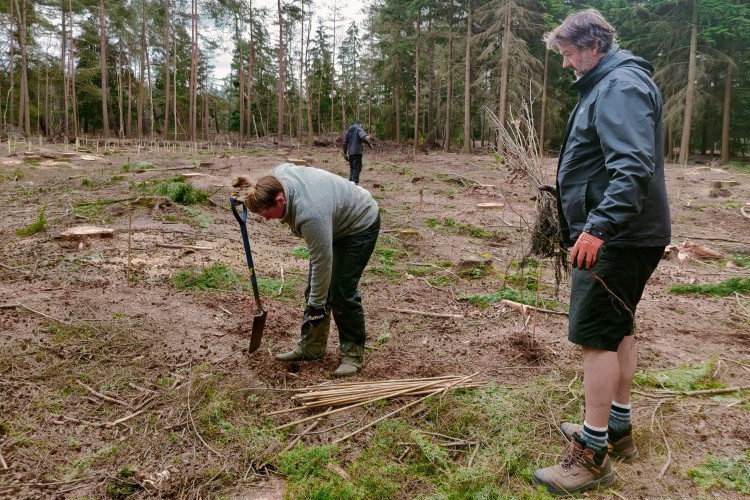Updated May 2025.
What we have been doing
We have been undertaking woodland management work at Buckler’s Forest, Crowthorne.
We have thinned trees and created temporary glades (open wooded areas) in some areas in the conifer plantation. The map below shows these areas.
We carried out this management work in 2 phases, last autumn and this January.
We have planted thousands of native trees to boost woodland regeneration.
This work is being done as part of the 10-year woodland management plan.
| Attachment | Size |
|---|---|
| 2 MB |
Why we did this
We have been doing this:
- as the work is identified in the woodland and site management plan
- to enhance the mix of wildlife-rich habitats
- to improve habitat connectivity, on site and into neighbouring areas
- to maintain and improve site amenity value for visitors
- for future maintenance requirements
- to build in resilience to factors, such as climate change and wildfires
Selective woodland thinning
The woodland plantation at Buckler’s Forest is made up of conifer species, which are of similar ages and heights. This type of monoculture is not good for woodland biodiversity. It is also a potential future maintenance concern.
The thinned areas will benefit species known to live at Buckler’s Forest and increase the lowland heath coverage on site.
This management work will establish a better mix of habitats, where wildlife can thrive and a more varied landscape for visitors to enjoy.
Temporary woodland glades - open areas
Glades are areas of open woodland, which are usually rich in wildlife.
We have established new temporary glades at Buckler’s Forest in areas where the most improvement to biodiversity can be made. This is in areas where Western Hemlock grows.
Western Hemlock is a non-native, evergreen species that grows densely, blocking out light for other species. Removing it will allow more light to reach the forest floor. This will benefit other young trees, shrubs and plants.
For the first 5 years, these temporary glades will serve as areas of open woodland. They will provide habitat for birds such as woodlarks and nightjars, which favour bare patches of ground and clearings for ground nesting.
Reptiles like slow worms and common lizards like these sunny spots, where they can warm themselves.
After 5 years, the glades will start to transform into new young mixed woodland. At this point, new temporary glades will be created in another part of the conifer plantation. In the long-term this will create a mosaic of age structures through the forest.

Woodland regeneration
We have planted native trees, to boost woodland regeneration in the three areas to the north.
We prepared the ground to give the new trees the best chances of survival, including scraping off the thick humus layer of needles.
Tree planting was finished by the end of March. We planted thousands of new trees, far more than the amount taken out.
We carefully selected the trees to include those species that are already found present on the site, and those which are happy to be planted in acidic soils. Trees have been protected from deer damage with either biodegradable guards, or guards recycled from the site.
Extending lowland heath
Lowland heath is a UK Biodiversity Action Plan Priority Habitat. Through the selective thinning, there will be more areas for plants such as heather to grow.
This will benefit heathland specific species, many of which are vulnerable across the UK and have been identified within the Bracknell Biodiversity Action Plan. Heathland areas have also been carefully selected to promote connectivity across the site and into neighbouring areas.
Precautions
We carefully prepared for these tree works. This includes consulting the relevant authorities such as Forestry Commission England and getting the necessary felling license (reference 1475).
Consultation on this proposal took place at the licence application stage. This is a statutory requirement as part of this process. The consultation was carried out by the Forestry Commission.
To minimise disruption to residents and visitors, we:
- consulted residents and businesses who may be directly affected by this work
- provided advanced site notices, so visitors could better plan their route
- shared news of these works with residents
- planned the work to take place outside of school summer holidays, when they would have less impact on visitors
- liaised with the Forestry Commission and a felling contractor who are experienced in carrying out this type of work
- carried the work out away from the road
- provided safety advice when the work was underway
To protect wildlife, we:
- carried out the work outside of bird nesting season
- took advice from experts to minimise disturbance to wildlife
Funding the work
Buckler’s Forest is owned by the Land Trust.
The Trust a charitable body which contracts with the council’s parks and countryside service to deliver on the agreed plans for the site.
There is no cost benefit to the council or the Land Trust for carrying out woodland management work.
Any revenue made from the timber sale will go towards the costs of the work tree planting and habitat maintenance.
